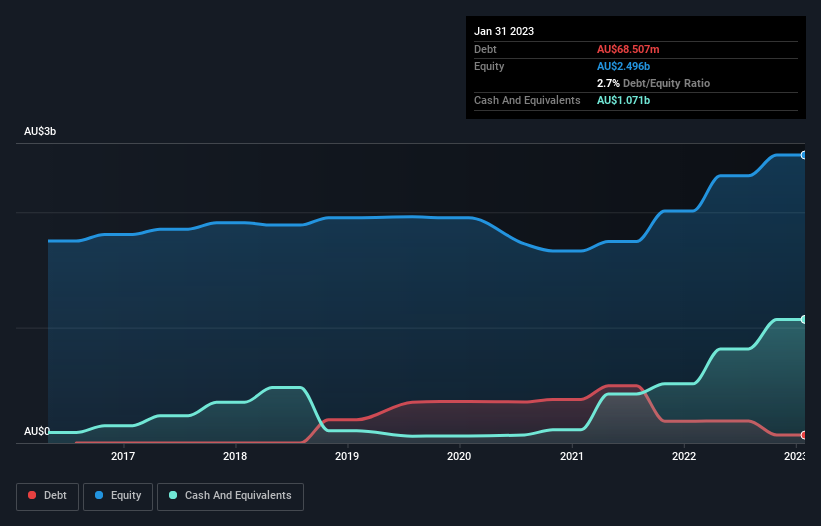Legendary fund manager Li Lu (who Charlie Munger backed) once said, 'The biggest investment risk is not the volatility of prices, but whether you will suffer a permanent loss of capital.' When we think about how risky a company is, we always like to look at its use of debt, since debt overload can lead to ruin. We note that New Hope Corporation Limited (ASX:NHC) does have debt on its balance sheet. But is this debt a concern to shareholders?
When Is Debt Dangerous?
Debt is a tool to help businesses grow, but if a business is incapable of paying off its lenders, then it exists at their mercy. Ultimately, if the company can't fulfill its legal obligations to repay debt, shareholders could walk away with nothing. However, a more usual (but still expensive) situation is where a company must dilute shareholders at a cheap share price simply to get debt under control. Of course, debt can be an important tool in businesses, particularly capital heavy businesses. When we examine debt levels, we first consider both cash and debt levels, together.
View our latest analysis for New Hope
What Is New Hope's Debt?
As you can see below, New Hope had AU$68.5m of debt at January 2023, down from AU$188.8m a year prior. But it also has AU$1.07b in cash to offset that, meaning it has AU$1.00b net cash.

How Strong Is New Hope's Balance Sheet?
We can see from the most recent balance sheet that New Hope had liabilities of AU$592.3m falling due within a year, and liabilities of AU$276.8m due beyond that. Offsetting these obligations, it had cash of AU$1.07b as well as receivables valued at AU$161.0m due within 12 months. So it actually has AU$363.2m more liquid assets than total liabilities.
This surplus suggests that New Hope has a conservative balance sheet, and could probably eliminate its debt without much difficulty. Simply put, the fact that New Hope has more cash than debt is arguably a good indication that it can manage its debt safely.
Even more impressive was the fact that New Hope grew its EBIT by 169% over twelve months. If maintained that growth will make the debt even more manageable in the years ahead. There's no doubt that we learn most about debt from the balance sheet. But it is future earnings, more than anything, that will determine New Hope's ability to maintain a healthy balance sheet going forward. So if you want to see what the professionals think, you might find this free report on analyst profit forecasts to be interesting.
But our final consideration is also important, because a company cannot pay debt with paper profits; it needs cold hard cash. New Hope may have net cash on the balance sheet, but it is still interesting to look at how well the business converts its earnings before interest and tax (EBIT) to free cash flow, because that will influence both its need for, and its capacity to manage debt. Over the last two years, New Hope recorded free cash flow worth a fulsome 82% of its EBIT, which is stronger than we'd usually expect. That puts it in a very strong position to pay down debt.
Summing Up
While we empathize with investors who find debt concerning, you should keep in mind that New Hope has net cash of AU$1.00b, as well as more liquid assets than liabilities. And it impressed us with free cash flow of AU$1.5b, being 82% of its EBIT. So we don't think New Hope's use of debt is risky. When analysing debt levels, the balance sheet is the obvious place to start. But ultimately, every company can contain risks that exist outside of the balance sheet. Case in point: We've spotted 3 warning signs for New Hope you should be aware of, and 1 of them makes us a bit uncomfortable.
If, after all that, you're more interested in a fast growing company with a rock-solid balance sheet, then check out our list of net cash growth stocks without delay.
Valuation is complex, but we're here to simplify it.
Discover if New Hope might be undervalued or overvalued with our detailed analysis, featuring fair value estimates, potential risks, dividends, insider trades, and its financial condition.
Access Free AnalysisHave feedback on this article? Concerned about the content? Get in touch with us directly. Alternatively, email editorial-team (at) simplywallst.com.
This article by Simply Wall St is general in nature. We provide commentary based on historical data and analyst forecasts only using an unbiased methodology and our articles are not intended to be financial advice. It does not constitute a recommendation to buy or sell any stock, and does not take account of your objectives, or your financial situation. We aim to bring you long-term focused analysis driven by fundamental data. Note that our analysis may not factor in the latest price-sensitive company announcements or qualitative material. Simply Wall St has no position in any stocks mentioned.
About ASX:NHC
Flawless balance sheet, undervalued and pays a dividend.
Similar Companies
Market Insights
Community Narratives



